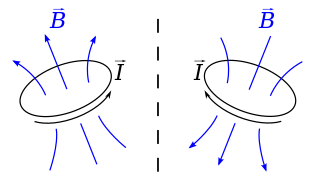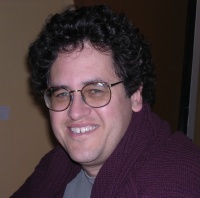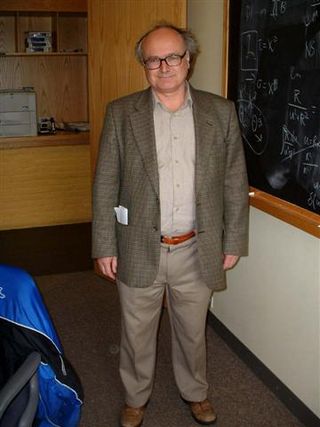Related Research Articles
In mathematics, a geometric algebra is an algebra that can represent and manipulate geometrical objects such as vectors. Geometric algebra is built out of two fundamental operations, addition and the geometric product. Multiplication of vectors results in higher-dimensional objects called multivectors. Compared to other formalisms for manipulating geometric objects, geometric algebra is noteworthy for supporting vector division and addition of objects of different dimensions.

Edward Witten is an American theoretical physicist known for his contributions to string theory, topological quantum field theory, and various areas of mathematics. He is a professor emeritus in the school of natural sciences at the Institute for Advanced Study in Princeton. Witten is a researcher in string theory, quantum gravity, supersymmetric quantum field theories, and other areas of mathematical physics. Witten's work has also significantly impacted pure mathematics. In 1990, he became the first physicist to be awarded a Fields Medal by the International Mathematical Union, for his mathematical insights in physics, such as his 1981 proof of the positive energy theorem in general relativity, and his interpretation of the Jones invariants of knots as Feynman integrals. He is considered the practical founder of M-theory.
In physics and astronomy, a frame of reference is an abstract coordinate system, whose origin, orientation, and scale have been specified in physical space. It is based on a set of reference points, defined as geometric points whose position is identified both mathematically and physically . An important special case is that of inertial reference frames, a stationary or uniformly moving frame.

In physics and mathematics, a pseudovector is a quantity that behaves like a vector in many situations, but its direction does not conform when the object is rigidly transformed by rotation, translation, reflection, etc. This can also happen when the orientation of the space is changed. For example, the angular momentum is a pseudovector because it is often described as a vector, but by just changing the position of reference, angular momentum can reverse direction, which is not supposed to happen with true vectors.

John Carlos Baez is an American mathematical physicist and a professor of mathematics at the University of California, Riverside (UCR) in Riverside, California. He has worked on spin foams in loop quantum gravity, applications of higher categories to physics, and applied category theory. Additionally, Baez is known on the World Wide Web as the author of the crackpot index.

William Kingdon Clifford was a British mathematician and philosopher. Building on the work of Hermann Grassmann, he introduced what is now termed geometric algebra, a special case of the Clifford algebra named in his honour. The operations of geometric algebra have the effect of mirroring, rotating, translating, and mapping the geometric objects that are being modelled to new positions. Clifford algebras in general and geometric algebra in particular have been of ever increasing importance to mathematical physics, geometry, and computing. Clifford was the first to suggest that gravitation might be a manifestation of an underlying geometry. In his philosophical writings he coined the expression mind-stuff.

David Orlin Hestenes is a theoretical physicist and science educator. He is best known as chief architect of geometric algebra as a unified language for mathematics and physics, and as founder of Modelling Instruction, a research-based program to reform K–12 Science, Technology, Engineering, and Mathematics (STEM) education.
In physics, the algebra of physical space (APS) is the use of the Clifford or geometric algebra Cl3,0(R) of the three-dimensional Euclidean space as a model for (3+1)-dimensional spacetime, representing a point in spacetime via a paravector.

Gary William Gibbons is a British theoretical physicist.

Steve Vickers is a British mathematician and computer scientist. In the early 1980s, he wrote ROM firmware and manuals for three home computers, the ZX81, ZX Spectrum, and Jupiter Ace. The latter was produced by Jupiter Cantab, a short-lived company Vickers formed together with Richard Altwasser, after the two had left Sinclair Research. Since the late 1980s, Vickers has been an academic in the field of geometric logic, writing over 30 papers in scholarly journals on mathematical aspects of computer science. His book Topology via Logic has been influential over a range of fields. In October 2018, he retired as senior lecturer at the University of Birmingham. As announced on his university homepage, he continues to supervise PhD students at the university and focus on his research.
In mathematical physics, spacetime algebra (STA) is the application of Clifford algebra Cl1,3(R), or equivalently the geometric algebra G(M4) to physics. Spacetime algebra provides a "unified, coordinate-free formulation for all of relativistic physics, including the Dirac equation, Maxwell equation and General Relativity" and "reduces the mathematical divide between classical, quantum and relativistic physics."
In mathematics, especially (higher) category theory, higher-dimensional algebra is the study of categorified structures. It has applications in nonabelian algebraic topology, and generalizes abstract algebra.

David Ian Olive ; 16 April 1937 – 7 November 2012) was a British theoretical physicist. Olive made fundamental contributions to string theory and duality theory, he is particularly known for his work on the GSO projection and Montonen–Olive duality.
In quantum field theory, gauge gravitation theory is the effort to extend Yang–Mills theory, which provides a universal description of the fundamental interactions, to describe gravity.
In the study of geometric algebras, a k-blade or a simple k-vector is a generalization of the concept of scalars and vectors to include simple bivectors, trivectors, etc. Specifically, a k-blade is a k-vector that can be expressed as the exterior product of 1-vectors, and is of gradek.
Gennadi Sardanashvily was a theoretical physicist, a principal research scientist of Moscow State University.
Chris J. L. Doran is a physicist, Director of Studies in Natural Sciences for Sidney Sussex College, Cambridge. He founded Geomerics, and is its Chief Operating Officer.
Conformal geometric algebra (CGA) is the geometric algebra constructed over the resultant space of a map from points in an n-dimensional base space Rp,q to null vectors in Rp+1,q+1. This allows operations on the base space, including reflections, rotations and translations to be represented using versors of the geometric algebra; and it is found that points, lines, planes, circles and spheres gain particularly natural and computationally amenable representations.
Gauge theory gravity (GTG) is a theory of gravitation cast in the mathematical language of geometric algebra. To those familiar with general relativity, it is highly reminiscent of the tetrad formalism although there are significant conceptual differences. Most notably, the background in GTG is flat, Minkowski spacetime. The equivalence principle is not assumed, but instead follows from the fact that the gauge covariant derivative is minimally coupled. As in general relativity, equations structurally identical to the Einstein field equations are derivable from a variational principle. A spin tensor can also be supported in a manner similar to Einstein–Cartan–Sciama–Kibble theory. GTG was first proposed by Lasenby, Doran, and Gull in 1998 as a fulfillment of partial results presented in 1993. The theory has not been widely adopted by the rest of the physics community, who have mostly opted for differential geometry approaches like that of the related gauge gravitation theory.
In geometric algebra, the outermorphism of a linear function between vector spaces is a natural extension of the map to arbitrary multivectors. It is the unique unital algebra homomorphism of exterior algebras whose restriction to the vector spaces is the original function.
References
- ↑ John Vince: Geometric Algebra: An Algebraic System for Computer Games and Animation, Springer, 2009, ISBN 978-1-84882-379-2, p. 3
- ↑ Val L. Fitch, Daniel R. Marlow, Margit Ann Elisabeth Dementi: Critical problems in physics: proceedings of a conference celebrating the 250th anniversary of Princeton university, Princeton University Press, 1997, ISBN 0-691-05785-0, p. 165
- ↑ J. Lasenby, A. N. Lasenby, C. J. L. Doran: A unified mathematical language for physics and engineering in the 21st century, Phil. Trans. R. Soc. Lond. A 358, 21-39 (2000) (abstract, full text)
- ↑ Lasenby, Anthony; Chris Doran; Stephen Gull (1998), "Gravity, gauge theories and geometric algebra", Philosophical Transactions of the Royal Society A , 356: 487–582, arXiv: gr-qc/0405033 , Bibcode:1998RSPTA.356..487L, doi:10.1098/rsta.1998.0178